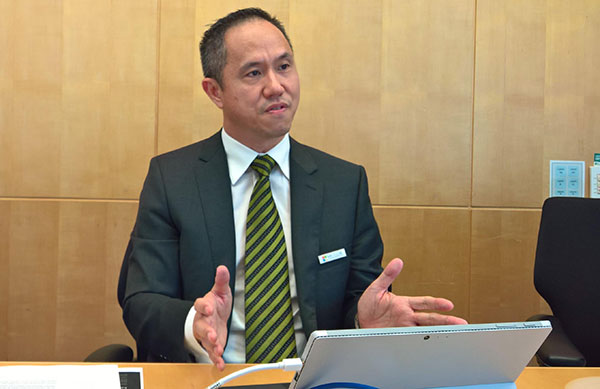Microsoft facility to strengthen transparency, cybersecurity in APAC

VIR talked to Eric Lam, director of Enterprise Cybersecurity Group, Microsoft Asia about the launch and the centre’s operation.
What is the significance of the launch of this combined facility?
The Singapore Transparency Centre was selected as a convenient location for governments in the Asia region and will be part of a global network that covers four regions, joining existing facilities in Redmond, Washington, for North America, and Brussels, Belgium, for Europe. In addition, a Transparency Centre is planned for the Latin America region, as well as a Transparency Centre in Beijing, which will officially open later in 2016.
On the other hand, the launch of the Microsoft Cybersecurity Centre underscores Microsoft’s continued commitment to building trust in technology and all that it promises. The centre aims to build upon the company’s cybercrime fighting efforts, and serves as a platform for Microsoft to foster a safer digital world by enabling deeper cybersecurity collaborations with public and private sector organisations in Singapore and the region.
Why did you choose Singapore as the location for the centre?
Singapore is the location of our Asia Pacific headquarters, and is a natural base for us to leverage the existing talent and resources to cater to the region’s governments and enterprises
You just shared that Microsoft invest more than $1 billion per year for security. What are some of the highlights in 2015?
In November 2015, Microsoft announced the launch of the Cyber Defense Operations Centre (CDOC), which brings together security response experts from across the company to help protect, detect, and respond to threats in real-time.
Staffed with dedicated teams 24x7, the centre has direct access to thousands of security professionals, data scientists, and product engineers throughout Microsoft to ensure rapid response and resolution to security threats.
Moreover, informed by trillions of data points across an extensive network of sensors, devices, authentications, and communications, the centre employs automated software, machine learning, behavioral analysis, and forensics to create an intelligent security graph. This threat intelligence insight helps our teams connect the dots, then counter with strong containment and coordinated remediation.
Another highlight of the year 2015 is the launch of the Enterprise Cybersecurity Group (ECG), which is a dedicated group of worldwide security experts who will deliver security solutions, expertise and services that empower organisations to modernise their IT platforms, securely move to the cloud and keep data safe.
ECG’s cybersecurity solutions can be categorised as to Protect, Detect and Respond. They protect customers’ most valuable assets by helping to prevent cyber-attacks, monitor customer networks to expose attacks, vulnerabilities and persistent threats, and investigate and disrupt suspicious events to provide diagnoses and recommended mitigations.
Microsoft has also made several security acquisitions in the past year: In November 2015, we acquired Secure Islands to accelerate our ability to help customers secure their business data no matter where it is stored - across on-premises systems, Microsoft cloud services like Azure and Office 365, and third party services, as well as any Windows, iOS or Android device. Secure Islands technology’ enhances the data protection capabilities available today with Azure Rights Management Service (RMS), Microsoft’s cloud-based information protection solution. Moving forward, Secure Islands’ technology will integrate into RMS to provide a flexible architecture able to meet the most rigorous protection and compliance requirements.
In September 2015, we acquired Adallom, whose technology also expands on Active Directory to give customers visibility and control over access to applications, as well as their critical company data stored across Microsoft and third party cloud services. Adallom will complement existing offerings that Microsoft makes available today as part of Office 365 and the Enterprise Mobility Suite (EMS), including Advanced Threat Analytics.
Did Microsoft have any activities in Asia in this respect last year?
Yes. In February 2015, Microsoft announced the launch of the Cybercrime Satellite Centre in Singapore (upgraded to today’s Cybercrime Centre), a satellite extension of the Microsoft Cybercrime Centre in Redmond in the US.
The centre in Singapore serves as a regional hub for Microsoft to undertake cybercrime and cybersecurity initiatives in the Asia Pacific region, through public-private partnerships and cross-industry collaboration. This includes all major Southeast Asian countries, as well as Australia, India, Korea and New Zealand.
It also includes collaborations with Interpol in at least three botnet disruption operations; a PhotoDNA partnership with Interpol; cyber forensics work for customers; as well as operations with local police.
The Cybersecurity Centre joins four others in Asia: in Beijing, India, Tokyo and Seoul.
| RELATED CONTENTS: | |
| Microsoft advances cybersecurity investments in Asia-Pacific | |
What the stars mean:
★ Poor ★ ★ Promising ★★★ Good ★★★★ Very good ★★★★★ Exceptional
Latest News
More News
- Businesses ramp up production as year-end orders surge (December 30, 2025 | 10:05)
- Vietjet chairwoman awarded Labour Hero title (December 29, 2025 | 13:06)
- How to unlock ESG value through green innovation (December 29, 2025 | 10:03)
- AI reshapes media and advertising industry (December 29, 2025 | 08:33)
- FPT and GELEX sign deal to develop blockchain tech for global markets (December 29, 2025 | 08:29)
- Vietnam’s GDP forecast to grow by 9 per cent in 2026 (December 29, 2025 | 08:29)
- Women entrepreneurs are key to Vietnam’s economic growth (December 29, 2025 | 08:00)
- Vietnam's top 500 value-creating enterprises announced (December 27, 2025 | 08:00)
- The PAN Group shaping a better future with ESG strategy (December 26, 2025 | 09:00)
- Masan Consumer officially lists on HSX, marking the next phase of value creation (December 25, 2025 | 13:20)

















 Mobile Version
Mobile Version